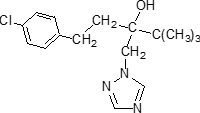Fungicide
Tebuconazole
TC & FORMULATION: 97%TC, 430G/L SC, 6%FS, 25%EC, 25%EW, 80%WP
Structure Formula 
NOMENCLATURE
Common name tebuconazole (BSI, draft E-ISO)
IUPAC name (RS)-1-p-chlorophenyl-4,4-dimethyl-3-(1H-1,2,4-triazol-1-ylmethyl)pentan-3-ol
Chemical Abstracts name (?-a-[2-(4-chlorophenyl)ethyl]-a-(1,1-dimethylethyl)-1H-1,2,4-triazole-1-ethanol
Other names fenetrazole*; terbuconazole*; terbutrazole*; ethyltrianol* CAS RN [107534-96-3] EEC no. ELINCS: 403-640-2
PHYSICAL CHEMISTRY
Composition Racemate. Mol. wt. 307.8 M.f. C16H22ClN3O Form Colourless crystals; (tech., colourless to light brown powder). M.p. 105 ºC V.p. 1.7 ´ 10-3 mPa (20 ºC) (OECD 104) KOW logP = 3.7 (20 °C) Henry 1 ´ 10-5 Pa m3 mol-1 (20 °C) S.g./density 1.25 (26 °C) Solubility In water 36 mg/l (pH 5-9, 20 ºC). In dichloromethane >200, isopropanol, toluene 50-100, hexane <0.1 (all in g/l, 20 ºC). Stability Stable to elevated temperatures, and to photolysis and hydrolysis in pure water, under sterile conditions; hydrolysis DT50 >1 y (pH 4-9, 22 °C). See also Environmental Fate.
APPLICATIONS
Biochemistry Steroid demethylation (ergosterol biosynthesis) inhibitor. Mode of action Systemic fungicide with protective, curative, and eradicant action. Rapidly absorbed into the vegetative parts of the plant, with translocation principally acropetally. Uses As a seed dressing, tebuconazole is effective against various smut and bunt diseases of cereals such as Tilletia spp., Ustilago spp., and Urocystis spp., also against Septoria nodorum (seed-borne), at 1-3 g/dt seed; and Sphacelotheca reiliana in maize, at 7.5 g/dt seed. As a spray, tebuconazole controls numerous pathogens in various crops including: rust species (Puccinia spp.) at 125-250 g/ha, powdery mildew (Erysiphe graminis) at 200-250 g/ha, scald (Rhynchosporium secalis) at 200-312 g/ha, Septoria spp. at 200-250 g/ha, Pyrenophora spp. at 200-312 g/ha, Cochliobolus sativus at 150-200 g/ha, and head scab (Fusarium spp.) at 188-250 g/ha, in cereals; leaf spots (Mycosphaerella spp.) at 125-250 g/ha, leaf rust (Puccinia arachidis) at 125 g/ha, and Sclerotium rolfsii at 200-250 g/ha, in peanuts; black leaf streak (Mycosphaerella fijiensis) at 100 g/ha, in bananas; stem rot (Sclerotinia sclerotiorum) at 250-375 g/ha, Alternaria spp. at 150-250 g/ha, stem canker (Leptosphaeria maculans) at 250 g/ha, and Pyrenopeziza brassicae at 125-250 g/ha, in oilseed rape; blister blight (Exobasidium vexans) at 25 g/ha, in tea; Phakopsora pachyrhizi at 100-150 g/ha, in soya beans; Monilinia spp. at 12.5-18.8 g/100 l, powdery mildew (Podosphaera leucotricha) at 10.0-12.5 g/100 l, Sphaerotheca pannosa at 12.5-18.8 g/100 l, scab (Venturia spp.) at 7.5-10.0 g/100 l, white rot in apples (Botryosphaeria dothidea) at 25 g/100 l, in pome and stone fruit; powdery mildew (Uncinula necator) at 100 g/ha, in grapevines; rust (Hemileia vastatrix) at 125-250 g/ha, berry spot disease (Cercospora coffeicola) at 188-250 g/ha, and American leaf disease (Mycena citricolor) at 125-188 g/ha, in coffee; white rot (Sclerotium cepivorum) at 250-375 g/ha, and purple blotch (Alternaria porri) at 125-250 g/ha, in bulb vegetables; leaf spot (Phaeoisariopsis griseola) at 250 g/ha, in beans; early blight (Alternaria solani) at 150-200 g/ha, in tomatoes and potatoes. Phytotoxicity Good plant compatibility in most crops with any formulation, and achieved in more sensitive crops by appropriate formulations, e.g. WP, WG or SC. Formulation types DS; EC; ES; EW; FS; GF; SC; SE; WG; WP; WS.
About price and product information, please click Message button.
Open the consulting page, please Writing information, customer manager will reply within 24 hours!
or Contact email:Donna.wen@molotuschem.com
Cell-phone number:17717500809
Tel:0086 21 61203246
Fax:0086 21 61612025
Address:Room 402, No.553, Maotai Road, Changning District, Shanghai.







